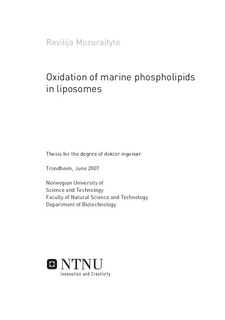| dc.contributor.author | Mozuraityte, Revilija | nb_NO |
| dc.date.accessioned | 2014-12-19T13:14:06Z | |
| dc.date.available | 2014-12-19T13:14:06Z | |
| dc.date.created | 2008-03-27 | nb_NO |
| dc.date.issued | 2007 | nb_NO |
| dc.identifier | 123867 | nb_NO |
| dc.identifier.isbn | 978-82-471-3148-0 | nb_NO |
| dc.identifier.uri | http://hdl.handle.net/11250/245575 | |
| dc.description.abstract | Marine phospholipids contain a high amount of n-3 polyunsaturated fatty acids (PUFAs), which have documented beneficial effect on human health. Due to this, marine phospholipids have a high potential for use in products for human consumption. However, due to the high amount of n-3 PUFAs, marine phospholipids are very susceptible to lipid oxidation, which cause loss of sensory and nutritional value in foods, some oxidation compounds are even toxic. A successful incorporation of marine phospholipids in processed foods would most probably be in the form of lipid dispersions, where some common constituents such as iron would be present. Iron, which is a very important mineral from a nutritional point of view, is also a very strong prooxidant. Studies of oxidation in oil/water systems catalysed by iron would provide valuable information on oxidation kinetics.
This thesis summarises the work done on oxidation of marine phospholipids in liposomes. Measurement of dissolved oxygen uptake was chosen as the main method to study lipid oxidation. This fast and simple method enabled screening of the influence of different conditions on oxidation.
The mechanism for iron catalyzed oxidation in liposomes is discussed. When Fe2+ was added to liposomes, an initial drop in dissolved oxygen followed by a slower linear oxygen uptake, was observed. Addition of Fe3+ induced only the linear oxygen uptake. The initial fast drop in dissolved oxygen was due to breakdown of preexisting lipid peroxides by Fe2+. In this reaction alkoxy radicals were formed and Fe2+ was oxidised to Fe3+. Fe3+ formed was further reduced by peroxides to Fe2+ at a slow rate (compared to Fe2+ oxidation rate). When equilibrium between Fe2+ and Fe3+ was achieved, the linear oxygen uptake was observed and Fe3+ became the rate limiting factor in the circulation between Fe3+ and Fe2+. Both alkoxy and peroxy radicals are presumably formed by breakdown of peroxides by Fe2+ and Fe3+. These radicals react with fatty acids giving a lipid radical reacting with oxygen.
The rate of slower linear oxygen consumption followed Arrhenius kinetics and the variation in activation energy found (60 – 87 kJ/moles*K). The rate of slower linear oxygen uptake in liposomes was proportional to the concentration of iron and the lipid concentration in the assay mixture. The oxygen consumption rate was dependent on pH with a maximum observed between pH 4 and 5. The pH effect was explained by the iron availability and Zeta potential changes at different pH. Different salts had different influence on the linear oxygen uptake in liposomes. Cations (Na+, K+, Ca+, Mg+) did not influence the rate of oxidation in the tested range (Ionic strength (I) 0 - 0.14 M). Among the tested anions: sulphates and nitrates did not change oxygen uptake rate significantly, but chlorides (KCl, NaCl, CaCl2) reduced the oxidation rate down to approximately 45 % and dihydrogen phosphate down to 14 %, when I=0.14M. The effect of Cl- and H2PO4 - was additive. When the liposomes contained different concentrations of chlorides, a linear relationship between oxygen uptake rate and Zeta potential was observed. When phosphate was added, the oxygen uptake rate was not related to the changes in Zeta potential.
The influence of pH, temperature, concentration of NaCl, phospholipids and Fe2+ on slower linear rate were described by mathematical equations. The modelled data based on the described equations fitted within 10% standard deviation with observed values. | nb_NO |
| dc.language | eng | nb_NO |
| dc.publisher | Fakultet for naturvitenskap og teknologi | nb_NO |
| dc.relation.ispartofseries | Doktoravhandlinger ved NTNU, 1503-8181; 2007:143 | nb_NO |
| dc.relation.haspart | Mozuraityte, Revilija; Rustad, Turid; Storrø, Ivar. Pro-oxidant activity of Fe2+ in oxidation of cod phospholipids in liposomes. European Journal of Lipid Science and Technology. 108(3): 218-226, 2006. | nb_NO |
| dc.relation.haspart | Mozuraityte, Revilija; Rustad, Turid; Storrø, Ivar. Oxidation of cod phospholipids in liposomes: Effects of salts, pH and zeta potential. European Journal of Lipid Science and Technology. 108(11): 944-950, 2006. | nb_NO |
| dc.title | Oxidation of marine phospholipids in liposomes | nb_NO |
| dc.type | Doctoral thesis | nb_NO |
| dc.contributor.department | Norges teknisk-naturvitenskapelige universitet, Fakultet for naturvitenskap og teknologi, Institutt for bioteknologi | nb_NO |
| dc.description.degree | dr.ing. | nb_NO |
| dc.description.degree | dr.ing. | en_GB |
